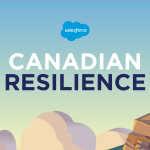Canadian retailers, like their peers all around the world, had little time to prepare for the impact of COVID-19 on their businesses, and the time they have now probably raises more questions than answers.
Though customers will gradually be allowed to visit physical stores as the outbreak is contained, the exact timeline may vary considerably from one province to another.
Much of the demand for products and services can only be fulfilled through e-commerce in the meantime, but how will spending patterns change?
What kind of experience — whether it’s contactless payments, curbside pickup or direct delivery — will consumers need and expect?
How should retailers maintain and nurture their existing relationships with customers when digital channels might be the primary option for weeks, or even months to come?
Fortunately, plenty of retailers had given themselves a good head start on combating many of these challenges, even if they never suspected something as transformative as the novel Coronavirus.
Digital transformation was already in progress across many parts of the retail sector in response to new ways consumers have been researching, deciding upon and purchasing their favourite products.
A big part of digital transformation is not merely using tools to manage operations, but moving to data-driven decision making as part of your strategy.
The problem in this case is having the right data, given the pandemic represents something unprecedented for most Canadian retailers.
This is where it’s helpful to look at outside sources of data such as the Salesforce Q1 Shopping Index. Powered by Commerce Cloud, it analyzes data from the activity of more than one billion global shoppers and shows a dramatic shift from physical to digital browsing and buying.
While the full Q1 Index is worth exploring in its entirety for a global perspective, we’ll call out some Canada-specific numbers in this post to help provide the most actionable insights:
The Stats: Commerce revenue grew 24% in Q1 in Canada compared to 16% growth in Q1 2019. Shopper Spend (the per-visit amount spent by shoppers) rose 10 cents YoY.
The Insight: Canada’s e-commerce growth was even higher than in the U.S., which may reflect the fact that our population is more spread out geographically. Regardless of the reason, the data makes it clear that customers continue to want to shop, even if they are sheltering-in-place.
The Action: Besides ensuring you have e-commerce capabilities in place, now is the time to develop a digital marketing strategy that makes consumers aware of what’s in stock, what they might need but haven’t thought of, and any way to ease the fulfillment side to align with social distancing guidelines.
The Stats: Sites offering buy online, pickup in store (BOPIS) grew digital revenue by 27% in Q1, compared with 13% for sites not offering BOPIS. Between March 10-20 specifically, digital revenue for sites offering BOPIS — via curbside, car, drive through, or store pickup — grew by 92% compared to 19% for sites not offering BOPIS over the same time period.
The Insight: While shoppers might have been content to wait for items to be shipped by physical mail before the pandemic, many now have the time to fetch what they’ve bought and are anxious to do so. This could become a competitive differentiator for the foreseeable future, if not table stakes across the retail sector in general.
The Action: Even though BOPIS seems to put the emphasis on the physical aspect of the experience, retailers need to continue thinking “omnichannel.” Be ready to answer questions from consumers about the status of their order and the time of the pickup by phone, email, text message or any other means the shopper prefers.
The Stats: The rate of online shoppers abandoning carts in Canada is much higher than in the U.S. It rose from 88% to 90% over the course of Q1, with the highest rate of abandonment happening on mobile devices (93%), compared to tablets (89%) and computers (86%).
The Insight: While we do tend to see increases in cart abandonment as traffic grows, there could be more to the story. Even if they’re rarely going outside their homes, don’t expect shoppers to be sitting in front of a desktop, where there’s plenty of room to navigate through a site. If mobile users aren’t finalizing a purchase, there’s likely some kind of friction in the experience that needs to be addressed.
The Action: Play “mystery shopper” for your own store using a mobile device. Even if you know the steps like the back of your hand, see if there are ways you could provide a more guided experience. Also think about how much data you’re collecting via e-commerce. It should be clear that any information you ask for will only improve what shoppers see, think and feel when they come back or hear from you afterwards.
The Stats: Although discount rates in the U.S. surged to 34% in mid-March, discount rates in Canada fell slightly between the end of Q4 and Q1, from 29% to 28%.
The Insight: Given we’re a smaller country with fewer shoppers, it might be understandable if retailers here felt they couldn’t offer as much in the way of discounts. That’s not the only alternative to galvanizing sales, however. Exclusive or limited-time collections of products or more personalized recommendations might be worth pursuing.
The Action: Study your own purchase data from previous quarters. Now is the time to jump on cross-sell or upsell opportunities that were on your “to-do” list before the pandemic. This is when demonstrating your ability to have a one-to-one relationship with your most valuable customers will really pay off.
The Stats: While purchases of essential goods grew globally by 200% in Q1, digital revenue grew by 51% for the Home Goods industry (like home decor and crafts), 31% YoY increase for Active Apparel (like athleisure), and a 34% YoY increase for Toys and Games.
The Insight: People can’t (and don’t want to) spend all their time working from home and watching or reading the news. They still need to be diverted and entertained, so don’t assume non-essential category sales will flatline. It may be time to think about a content strategy that complements those non-essential items.
The Action: Consider whether you could offer virtual consultations on non-essential products via videoconferencing or related tools. Maybe you could offer ideas and inspiration on how to have more fun with certain products through an Instagram Live or Facebook Live event. Even your blog and newsletter could offer customers ways to make the best of a challenging situation.
Data-driven thinking can be key to business success at any time, but for retailers it’s more powerful than ever before. Continue exploring the Q1 Shopping Index yourself to develop a unique strategy to stay agile and grow, even during COVID-19.























